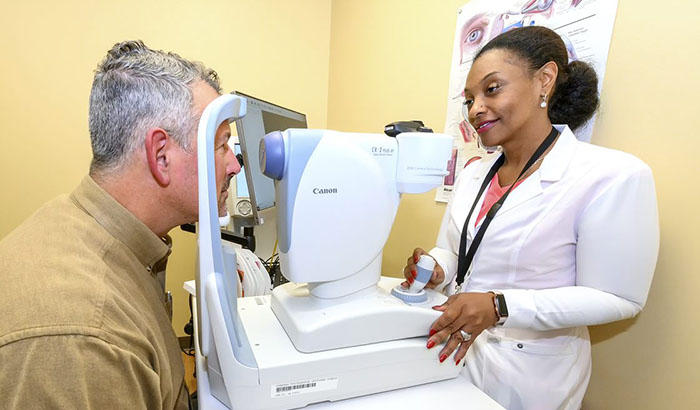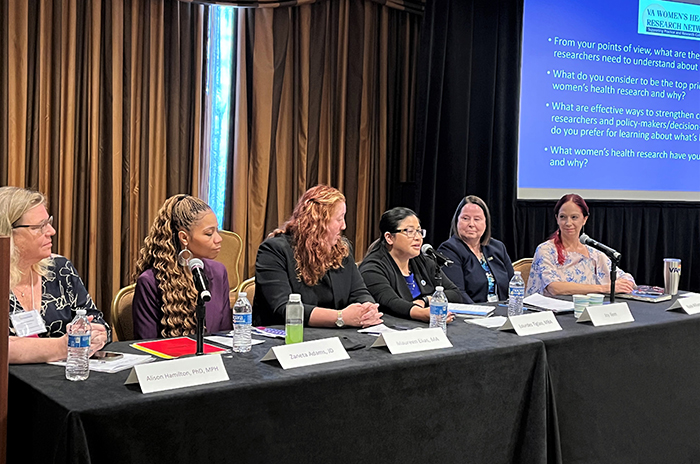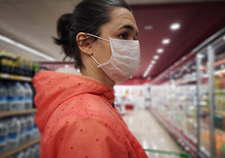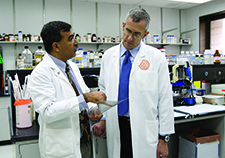Office of Research & Development |
 |


Nguyen Walker demonstrates the use of a digital retinal camera—an important part of remote eye screening—with Army Veteran Bill Beverley-Blanco. (Photo by Lisa Pessin)
February 3, 2020
By Erica Sprey
VA Research Communications
"We can bring the patient a huge amount of subspecialty care that they might not otherwise have access to."
Imagine that you are a retired military Veteran who lives in a remote section of Montana. The air is pristine, the hunting is great, and you know most of the residents in your small town by first name.
You count yourself lucky to have access to the VA community-based outpatient clinic in nearby Kalispell. But if you need specialized medical services, like eye care, it's a four-hour drive to the nearest VA medical center in Ft. Harrison, Montana. One way.
This hypothetical scenario is not unusual. More than 4.5 million Veterans in the U.S. live in rural communities. That's why VA has become a leader in the development of telehealth, tele-mental health, and tele-eye services.
In 2015, VA launched the Technology-based Eye Care Services program—otherwise known as TECS. The tele-eye screening program now serves 22 VA health care facilities across the country.
The purpose is to bring remote eye screening services to rural or underserved Veterans who might otherwise have problems gaining access to a screening eye exam or new glasses. It is not intended to replace an in-person eye exam and is one of several options that Veterans can choose for their eye care.
"Vision is an important part of a person's life," notes Dr. April Maa, a researcher at the Atlanta VA Medical Center who has studied TECS. "There are some very good studies that show if you can't see well or are blind, you are much more likely to fall or end up in a nursing home. You have a poorer quality of life and you are more likely to get depressed and become socially isolated."
The TECS tele-eye program is able to accurately detect the four most common eye conditions that cause visual impairment in an aging population—diabetic retinopathy, glaucoma, macular degeneration, and cataracts. Previous studies had established that the baseline TECS protocol is highly accurate when compared to an in-person eye exam by an ophthalmologist.
Maa and her coauthors recently published a study that tested the impact of adding of a special imaging test called optical coherence tomography (OCT) to the TECS screening exam. They found that adding OCT did not improve remote eye providers' accuracy in detecting glaucoma or retinal disease.

2023 VA Women's Health Research Conference

Photos shed light on food insecurity in post 9/11 Veterans

VA in new research agreement with National Institute of Allergy and Infectious Diseases
The researchers conducted a prospective clinical trial, following 256 Veterans with no known eye disease. Each patient received both an in-person eye exam by an ophthalmologist and screening using the TECS protocol with OCT.
Results from the TECS screening were interpreted by two separate "readers," off-site eye-care providers who reviewed clinical data, photographic images, and OCTs of the Veterans' eyes. The findings from reader #1 and reader #2 were then compared with the findings from the in-person eye exam to calculate reader variability and accuracy with OCT.
The study reaffirmed high agreement between the TECS screening protocol and the face-to-face exam for four common eye conditions. The agreement ranged from 84% to 98%. Remote readers had substantial agreement with the in-person exam for the diagnosis of cataracts and diabetic retinopathy. They had moderate to substantial agreement for glaucoma and suspected glaucoma. And they showed moderate agreement when diagnosing age-related macular degeneration.
The researchers found that adding OCT to the screening battery did not improve readers' accuracy, and in some cases worsened agreement with the in-person exam. OCT is an imaging technique that can show very small, sub-micrometer structures within the eye. It is commonly used in the treatment of retinal diseases. It is like an ultrasound of the eye, but it uses light instead of sound waves to create an image.
The researchers suggested that further study was necessary and speculated that the OCT results might change if the readers were glaucoma or retinal specialists who were well-versed in reading OCT images.
Maa is the clinical director for regional telehealth services, a VISN 7 resource based at the Atlanta VA Medical Center, and section chief for the TECS program. She is a comprehensive ophthalmologist who divides her time between treating eye disease and performing surgery, helping Veterans preserve their vision, and training ophthalmology residents. TECS is her brainchild.
Studies have shown that rural Veterans are less likely to seek vision care if they live far from their health care providers or have travel barriers. Older rural Veterans are also at greater risk of experiencing a blinding condition than their urban counterparts. Compounding that problem, delaying eye screening for diseases like glaucoma, that are more difficult to treat at later stages, can also put Veterans at greater risk for losing their vision.
Maa and her colleagues saw a need for tele-eye services within the VISN 7 catchment area, which includes many rural communities in Alabama and Georgia. They anticipated that tele-eye care could help provide specialized eye care at VA facilities that did not have eye clinics or an on-staff eye provider. They hoped that it could also improve wait times for patients. Prior to TECS implementation, Maa said Veterans at the Atlanta VA had long waits to see an eye doctor.
"My entire team is passionate about health care disparities. Just because you live in [rural] Blairsville, Georgia, doesn't mean you should get less care than other people," said Maa. "Those system-based barriers are reduced with telemedicine. We can bring the patient a huge amount of subspecialty care that they might not otherwise have access to."
Vision care is well-suited to telehealth, says Maa. Not unlike radiologists who often work remotely, eye providers do not need to be present when examining photographs of patients' eyes.
In the TECS program, a trained ophthalmology technician sees patients at their primary care clinic, gathering a medical history, taking vision measurements, and conducting a manifest refraction test—the process of measuring the degree of nearsightedness, farsightedness, and astigmatism for glasses. The technician also measures eye pressure and takes photographs of the patients' retina, a thin membrane that lies along the inner surface of the back of the eye.
Once the technician visit is complete, the patient's data and photographs are shared with a remote eye specialist who will review the results, make referrals, and prescribe eyeglasses or medication, if necessary. If patients require a follow-up visit, they will receive a call from the provider. If everything is good, the patient will receive a notice from the provider informing them of their results. Maa says that the TECS screening should be alternated with regular in-person eye exams.
TECS is a program that Maa says both rural Veterans and their health care providers value.
"The patients love it and the primary care providers appreciate having eye services at the primary care clinic. We have been able to pick up a lot of very serious eye disease in our Veterans to prevent blindness and get them timely access to care."
VA Research Currents archives || Sign up for VA Research updates